License
Attribution-ShareAlike 4.0 International
=======================================================================
Creative Commons Corporation ("Creative Commons") is not a law firm and
does not provide legal services or legal advice. Distribution of
Creative Commons public licenses does not create a lawyer-client or
other relationship. Creative Commons makes its licenses and related
information available on an "as-is" basis. Creative Commons gives no
warranties regarding its licenses, any material licensed under their
terms and conditions, or any related information. Creative Commons
disclaims all liability for damages resulting from their use to the
fullest extent possible.
Using Creative Commons Public Licenses
Creative Commons public licenses provide a standard set of terms and
conditions that creators and other rights holders may use to share
original works of authorship and other material subject to copyright
and certain other rights specified in the public license below. The
following considerations are for informational purposes only, are not
exhaustive, and do not form part of our licenses.
Considerations for licensors: Our public licenses are
intended for use by those authorized to give the public
permission to use material in ways otherwise restricted by
copyright and certain other rights. Our licenses are
irrevocable. Licensors should read and understand the terms
and conditions of the license they choose before applying it.
Licensors should also secure all rights necessary before
applying our licenses so that the public can reuse the
material as expected. Licensors should clearly mark any
material not subject to the license. This includes other CC-
licensed material, or material used under an exception or
limitation to copyright. More considerations for licensors:
wiki.creativecommons.org/Considerations_for_licensors
Considerations for the public: By using one of our public
licenses, a licensor grants the public permission to use the
licensed material under specified terms and conditions. If
the licensor's permission is not necessary for any reason--for
example, because of any applicable exception or limitation to
copyright--then that use is not regulated by the license. Our
licenses grant only permissions under copyright and certain
other rights that a licensor has authority to grant. Use of
the licensed material may still be restricted for other
reasons, including because others have copyright or other
rights in the material. A licensor may make special requests,
such as asking that all changes be marked or described.
Although not required by our licenses, you are encouraged to
respect those requests where reasonable. More considerations
for the public:
wiki.creativecommons.org/Considerations_for_licensees
=======================================================================
Creative Commons Attribution-ShareAlike 4.0 International Public
License
By exercising the Licensed Rights (defined below), You accept and agree
to be bound by the terms and conditions of this Creative Commons
Attribution-ShareAlike 4.0 International Public License ("Public
License"). To the extent this Public License may be interpreted as a
contract, You are granted the Licensed Rights in consideration of Your
acceptance of these terms and conditions, and the Licensor grants You
such rights in consideration of benefits the Licensor receives from
making the Licensed Material available under these terms and
conditions.
Section 1 -- Definitions.
a. Adapted Material means material subject to Copyright and Similar
Rights that is derived from or based upon the Licensed Material
and in which the Licensed Material is translated, altered,
arranged, transformed, or otherwise modified in a manner requiring
permission under the Copyright and Similar Rights held by the
Licensor. For purposes of this Public License, where the Licensed
Material is a musical work, performance, or sound recording,
Adapted Material is always produced where the Licensed Material is
synched in timed relation with a moving image.
b. Adapter's License means the license You apply to Your Copyright
and Similar Rights in Your contributions to Adapted Material in
accordance with the terms and conditions of this Public License.
c. BY-SA Compatible License means a license listed at
creativecommons.org/compatiblelicenses, approved by Creative
Commons as essentially the equivalent of this Public License.
d. Copyright and Similar Rights means copyright and/or similar rights
closely related to copyright including, without limitation,
performance, broadcast, sound recording, and Sui Generis Database
Rights, without regard to how the rights are labeled or
categorized. For purposes of this Public License, the rights
specified in Section 2(b)(1)-(2) are not Copyright and Similar
Rights.
e. Effective Technological Measures means those measures that, in the
absence of proper authority, may not be circumvented under laws
fulfilling obligations under Article 11 of the WIPO Copyright
Treaty adopted on December 20, 1996, and/or similar international
agreements.
f. Exceptions and Limitations means fair use, fair dealing, and/or
any other exception or limitation to Copyright and Similar Rights
that applies to Your use of the Licensed Material.
g. License Elements means the license attributes listed in the name
of a Creative Commons Public License. The License Elements of this
Public License are Attribution and ShareAlike.
h. Licensed Material means the artistic or literary work, database,
or other material to which the Licensor applied this Public
License.
i. Licensed Rights means the rights granted to You subject to the
terms and conditions of this Public License, which are limited to
all Copyright and Similar Rights that apply to Your use of the
Licensed Material and that the Licensor has authority to license.
j. Licensor means the individual(s) or entity(ies) granting rights
under this Public License.
k. Share means to provide material to the public by any means or
process that requires permission under the Licensed Rights, such
as reproduction, public display, public performance, distribution,
dissemination, communication, or importation, and to make material
available to the public including in ways that members of the
public may access the material from a place and at a time
individually chosen by them.
l. Sui Generis Database Rights means rights other than copyright
resulting from Directive 96/9/EC of the European Parliament and of
the Council of 11 March 1996 on the legal protection of databases,
as amended and/or succeeded, as well as other essentially
equivalent rights anywhere in the world.
m. You means the individual or entity exercising the Licensed Rights
under this Public License. Your has a corresponding meaning.
Section 2 -- Scope.
a. License grant.
1. Subject to the terms and conditions of this Public License,
the Licensor hereby grants You a worldwide, royalty-free,
non-sublicensable, non-exclusive, irrevocable license to
exercise the Licensed Rights in the Licensed Material to:
a. reproduce and Share the Licensed Material, in whole or
in part; and
b. produce, reproduce, and Share Adapted Material.
2. Exceptions and Limitations. For the avoidance of doubt, where
Exceptions and Limitations apply to Your use, this Public
License does not apply, and You do not need to comply with
its terms and conditions.
3. Term. The term of this Public License is specified in Section
6(a).
4. Media and formats; technical modifications allowed. The
Licensor authorizes You to exercise the Licensed Rights in
all media and formats whether now known or hereafter created,
and to make technical modifications necessary to do so. The
Licensor waives and/or agrees not to assert any right or
authority to forbid You from making technical modifications
necessary to exercise the Licensed Rights, including
technical modifications necessary to circumvent Effective
Technological Measures. For purposes of this Public License,
simply making modifications authorized by this Section 2(a)
(4) never produces Adapted Material.
5. Downstream recipients.
a. Offer from the Licensor -- Licensed Material. Every
recipient of the Licensed Material automatically
receives an offer from the Licensor to exercise the
Licensed Rights under the terms and conditions of this
Public License.
b. Additional offer from the Licensor -- Adapted Material.
Every recipient of Adapted Material from You
automatically receives an offer from the Licensor to
exercise the Licensed Rights in the Adapted Material
under the conditions of the Adapter's License You apply.
c. No downstream restrictions. You may not offer or impose
any additional or different terms or conditions on, or
apply any Effective Technological Measures to, the
Licensed Material if doing so restricts exercise of the
Licensed Rights by any recipient of the Licensed
Material.
6. No endorsement. Nothing in this Public License constitutes or
may be construed as permission to assert or imply that You
are, or that Your use of the Licensed Material is, connected
with, or sponsored, endorsed, or granted official status by,
the Licensor or others designated to receive attribution as
provided in Section 3(a)(1)(A)(i).
b. Other rights.
1. Moral rights, such as the right of integrity, are not
licensed under this Public License, nor are publicity,
privacy, and/or other similar personality rights; however, to
the extent possible, the Licensor waives and/or agrees not to
assert any such rights held by the Licensor to the limited
extent necessary to allow You to exercise the Licensed
Rights, but not otherwise.
2. Patent and trademark rights are not licensed under this
Public License.
3. To the extent possible, the Licensor waives any right to
collect royalties from You for the exercise of the Licensed
Rights, whether directly or through a collecting society
under any voluntary or waivable statutory or compulsory
licensing scheme. In all other cases the Licensor expressly
reserves any right to collect such royalties.
Section 3 -- License Conditions.
Your exercise of the Licensed Rights is expressly made subject to the
following conditions.
a. Attribution.
1. If You Share the Licensed Material (including in modified
form), You must:
a. retain the following if it is supplied by the Licensor
with the Licensed Material:
i. identification of the creator(s) of the Licensed
Material and any others designated to receive
attribution, in any reasonable manner requested by
the Licensor (including by pseudonym if
designated);
ii. a copyright notice;
iii. a notice that refers to this Public License;
iv. a notice that refers to the disclaimer of
warranties;
v. a URI or hyperlink to the Licensed Material to the
extent reasonably practicable;
b. indicate if You modified the Licensed Material and
retain an indication of any previous modifications; and
c. indicate the Licensed Material is licensed under this
Public License, and include the text of, or the URI or
hyperlink to, this Public License.
2. You may satisfy the conditions in Section 3(a)(1) in any
reasonable manner based on the medium, means, and context in
which You Share the Licensed Material. For example, it may be
reasonable to satisfy the conditions by providing a URI or
hyperlink to a resource that includes the required
information.
3. If requested by the Licensor, You must remove any of the
information required by Section 3(a)(1)(A) to the extent
reasonably practicable.
b. ShareAlike.
In addition to the conditions in Section 3(a), if You Share
Adapted Material You produce, the following conditions also apply.
1. The Adapter's License You apply must be a Creative Commons
license with the same License Elements, this version or
later, or a BY-SA Compatible License.
2. You must include the text of, or the URI or hyperlink to, the
Adapter's License You apply. You may satisfy this condition
in any reasonable manner based on the medium, means, and
context in which You Share Adapted Material.
3. You may not offer or impose any additional or different terms
or conditions on, or apply any Effective Technological
Measures to, Adapted Material that restrict exercise of the
rights granted under the Adapter's License You apply.
Section 4 -- Sui Generis Database Rights.
Where the Licensed Rights include Sui Generis Database Rights that
apply to Your use of the Licensed Material:
a. for the avoidance of doubt, Section 2(a)(1) grants You the right
to extract, reuse, reproduce, and Share all or a substantial
portion of the contents of the database;
b. if You include all or a substantial portion of the database
contents in a database in which You have Sui Generis Database
Rights, then the database in which You have Sui Generis Database
Rights (but not its individual contents) is Adapted Material,
including for purposes of Section 3(b); and
c. You must comply with the conditions in Section 3(a) if You Share
all or a substantial portion of the contents of the database.
For the avoidance of doubt, this Section 4 supplements and does not
replace Your obligations under this Public License where the Licensed
Rights include other Copyright and Similar Rights.
Section 5 -- Disclaimer of Warranties and Limitation of Liability.
a. UNLESS OTHERWISE SEPARATELY UNDERTAKEN BY THE LICENSOR, TO THE
EXTENT POSSIBLE, THE LICENSOR OFFERS THE LICENSED MATERIAL AS-IS
AND AS-AVAILABLE, AND MAKES NO REPRESENTATIONS OR WARRANTIES OF
ANY KIND CONCERNING THE LICENSED MATERIAL, WHETHER EXPRESS,
IMPLIED, STATUTORY, OR OTHER. THIS INCLUDES, WITHOUT LIMITATION,
WARRANTIES OF TITLE, MERCHANTABILITY, FITNESS FOR A PARTICULAR
PURPOSE, NON-INFRINGEMENT, ABSENCE OF LATENT OR OTHER DEFECTS,
ACCURACY, OR THE PRESENCE OR ABSENCE OF ERRORS, WHETHER OR NOT
KNOWN OR DISCOVERABLE. WHERE DISCLAIMERS OF WARRANTIES ARE NOT
ALLOWED IN FULL OR IN PART, THIS DISCLAIMER MAY NOT APPLY TO YOU.
b. TO THE EXTENT POSSIBLE, IN NO EVENT WILL THE LICENSOR BE LIABLE
TO YOU ON ANY LEGAL THEORY (INCLUDING, WITHOUT LIMITATION,
NEGLIGENCE) OR OTHERWISE FOR ANY DIRECT, SPECIAL, INDIRECT,
INCIDENTAL, CONSEQUENTIAL, PUNITIVE, EXEMPLARY, OR OTHER LOSSES,
COSTS, EXPENSES, OR DAMAGES ARISING OUT OF THIS PUBLIC LICENSE OR
USE OF THE LICENSED MATERIAL, EVEN IF THE LICENSOR HAS BEEN
ADVISED OF THE POSSIBILITY OF SUCH LOSSES, COSTS, EXPENSES, OR
DAMAGES. WHERE A LIMITATION OF LIABILITY IS NOT ALLOWED IN FULL OR
IN PART, THIS LIMITATION MAY NOT APPLY TO YOU.
c. The disclaimer of warranties and limitation of liability provided
above shall be interpreted in a manner that, to the extent
possible, most closely approximates an absolute disclaimer and
waiver of all liability.
Section 6 -- Term and Termination.
a. This Public License applies for the term of the Copyright and
Similar Rights licensed here. However, if You fail to comply with
this Public License, then Your rights under this Public License
terminate automatically.
b. Where Your right to use the Licensed Material has terminated under
Section 6(a), it reinstates:
1. automatically as of the date the violation is cured, provided
it is cured within 30 days of Your discovery of the
violation; or
2. upon express reinstatement by the Licensor.
For the avoidance of doubt, this Section 6(b) does not affect any
right the Licensor may have to seek remedies for Your violations
of this Public License.
c. For the avoidance of doubt, the Licensor may also offer the
Licensed Material under separate terms or conditions or stop
distributing the Licensed Material at any time; however, doing so
will not terminate this Public License.
d. Sections 1, 5, 6, 7, and 8 survive termination of this Public
License.
Section 7 -- Other Terms and Conditions.
a. The Licensor shall not be bound by any additional or different
terms or conditions communicated by You unless expressly agreed.
b. Any arrangements, understandings, or agreements regarding the
Licensed Material not stated herein are separate from and
independent of the terms and conditions of this Public License.
Section 8 -- Interpretation.
a. For the avoidance of doubt, this Public License does not, and
shall not be interpreted to, reduce, limit, restrict, or impose
conditions on any use of the Licensed Material that could lawfully
be made without permission under this Public License.
b. To the extent possible, if any provision of this Public License is
deemed unenforceable, it shall be automatically reformed to the
minimum extent necessary to make it enforceable. If the provision
cannot be reformed, it shall be severed from this Public License
without affecting the enforceability of the remaining terms and
conditions.
c. No term or condition of this Public License will be waived and no
failure to comply consented to unless expressly agreed to by the
Licensor.
d. Nothing in this Public License constitutes or may be interpreted
as a limitation upon, or waiver of, any privileges and immunities
that apply to the Licensor or You, including from the legal
processes of any jurisdiction or authority.
=======================================================================
Creative Commons is not a party to its public licenses.
Notwithstanding, Creative Commons may elect to apply one of its public
licenses to material it publishes and in those instances will be
considered the “Licensor.” The text of the Creative Commons public
licenses is dedicated to the public domain under the CC0 Public Domain
Dedication. Except for the limited purpose of indicating that material
is shared under a Creative Commons public license or as otherwise
permitted by the Creative Commons policies published at
creativecommons.org/policies, Creative Commons does not authorize the
use of the trademark "Creative Commons" or any other trademark or logo
of Creative Commons without its prior written consent including,
without limitation, in connection with any unauthorized modifications
to any of its public licenses or any other arrangements,
understandings, or agreements concerning use of licensed material. For
the avoidance of doubt, this paragraph does not form part of the public
licenses.
Creative Commons may be contacted at creativecommons.org.
Properties of Fluids
What is a Fluid?
- A fluid may be liquid, vapour, or gas
- No permanent shape
- Consists of atoms in random motion and continual collision
- Easy to deform
- Liquids have fixed volume, gasses fill up container
- A fluid is a substance for which a shear stress tends to produce unlimited, continuous deformation
Shear Forces
- For a solid, application of shear stress causes a deformation which, if not too great (elastic), is not permanent and solid regains original position
- For a fluid, continuous deformation takes place as the molecules slide over each other until the force is removed
Density
- Density:
- Specific Density:
Obtaining Density
Find mass of a given volume or volume of a given mass
This gives average density and assumes density is the same throughout
- This is not always the case (like in chocolate chip ice cream)
- Bulk density is often used to refer to average density
Engineering Density
- Matter is not continuous on molecular scale
- For fluids in constant motion, we take a time average
- For most practical purposes, matter is considered to be homogeneous and time averaged
Pressure
Pressure is a scalar quantity
Gases cannot sustain tensile stress, liquids a negligible amount
There is a certain amount of energy associated with the random continuous motion of the molecules
Higher pressure fluids tend to have more energy in their molecules
How Does Molecular Motion Create Force?
When molecules interact with each other, there is no net force
When they interact with walls, there is a resultant force perpendicular to the surface
Pressure caused my molecule:
If we want total force, we have to add them all up
-
- If pressure is constant, then this integrates to
- These equations can be used if pressure is constant of average value is appropriate
- For many cases in fluids pressure is not constant
Pressure Variation in a Static Fluid
- A fluid at rest has constant pressure horizontally
- That’s why liquid surfaces are flat
- But fluids at rest do have a vertical gradient, where lower parts have higher pressure
How Does Pressure Vary with Depth?
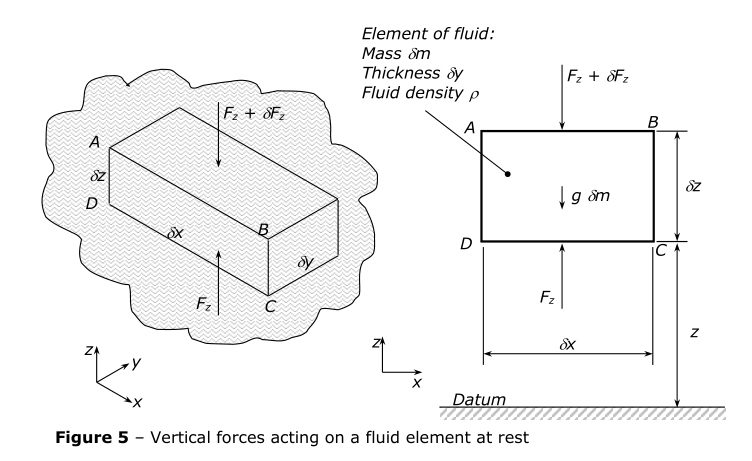
Let fluid pressure be p at height , and at .
Force acts upwards to support the fluid, countering pressure .
Force acts downwards to counter pressure and comes from the weight of the liquid above.
Now:
Resolving forces in z direction:
The equation applies for any fluid. The -ve sign indicates that as , height, increases, , pressure, decreases.
Absolute and Gauge Pressure
Absolute Pressure is measured relative to zero (a vacuum)
Gauge pressure = absolute pressure - atmospheric pressure
- Often used in industry
If absolute pressure = 3 bar and atmospheric pressure is 1 bar, then gauge pressure = 2 bar
Atmospheric pressure changes with altitude
Compressibility
- All fluids are compressible, especially gasses
- Most liquids can be considered incompressible most of the time (and will be in MMME1048, but may not be in future modules)
Surface Tension
- In a liquid, molecules are held together by molecular attraction
- At a boundary between two fluids this creates “surface tension”
- Surface tension usually has the symbol
Ideal Gas
No real gas is perfect, although many are similar
We define a specific gas constant to allow us to analyse the behaviour of a specific gas:
(Universal Gas Constant / molar mass of gas)
Perfect gas law
or
- Pressure always in Pa
- Temperature always in K
Units and Dimensional Analysis
- It is usually better to use SI units
- If in doubt, DA can be useful to check that your answer makes sense
Fluid Statics
Manometers
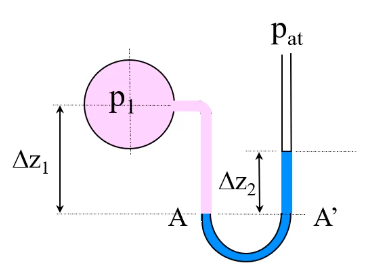
- Manometers work on the principle that pressure along any horizontal plane through a continuous fluid is constant
- Manometers can be used to measure the pressure of a gas, vapour, or liquid
- Manometers can measure higher pressures than a piezometer
- Manometer fluid and working should be immiscible (don’t mix)
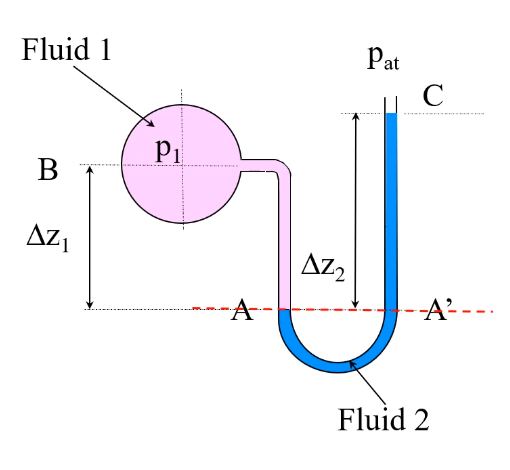
Left hand side:
Right hand side:
Equate and rearrange:
If :
Differential U-Tube Manometer
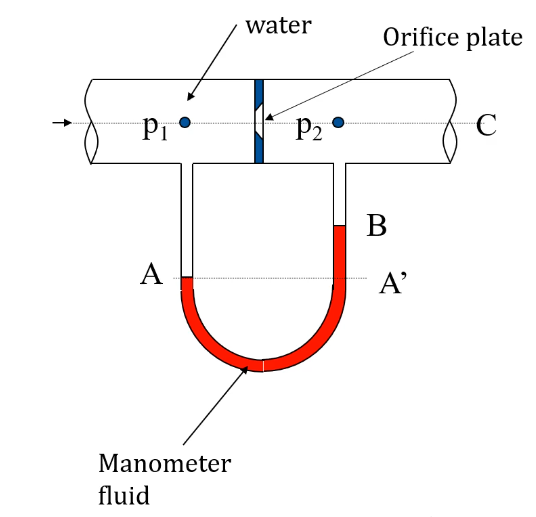
- Used to find the difference between two unknown pressures
- Can be used for any fluid that doesn’t react with manometer fluid
- Same principle used in analysis
Left hand side:
Right hand side:
Right hand manometer fluid:
Angled Differential Manometer

If the pipe is sloped then
as is lower
If there is no flow along the tube, then
Exercise Sheet 1
If 4 m of oil weighs 35 kN calculate its density and relative density. Relative density is a term used to define the density of a fluid relative
Find the pressure relative to atmospheric experienced by a diver working on the sea bed at a depth of 35 m. Take the density of sea water to be 1030 kgm.
An open glass is sitting on a table, it has a diameter of 10 cm. If water up to a height of 20 cm is now added calculate the force exerted onto the table by the addition of the water.
A closed rectangular tank with internal dimensions 6m x 3m x 1.5m high has a vertical riser pipe of cross-sectional area 0.001 m2 in
the upper surface (figure 1.4). The tank and riser are filled with water such that the water level in the riser pipe is 3.5 m above theCalculate:
The gauge pressure at the base of the tank.
The gauge pressure at the top of the tank.
The force exerted on the base of the tank due to gauge water pressure.
The weight of the water in the tank and riser.
Explain the difference between (iii) and (iv).
(It may be helpful to think about the forces on the top of the tank)
The pressure at the top of the tank is higher than atmospheric pressure because of the riser. This means there is an upwards force on the top of tank. The difference between the force acting up and down due to pressure is equal to the weight of the water.
A double U-tube manometer is connected to a pipe as shown below.
Taking the dimensions and fluids as indicated; calculate the absolute pressure at point A (centre of the pipe).
Take atmospheric pressure as 1.01 bar and the density of mercury as 13600 kgm.

Submerged Surfaces
Preparatory Maths
Integration as Summation
Centroids
- For a 3D body, the centre of gravity is the point at which all the mass can be considered to act
- For a 2D lamina (thin, flat plate) the centroid is the centre of area, the point about which the lamina would balance
To find the location of the centroid, take moments (of area) about a suitable reference axis:
(making the assumption that the surface has a unit mass per unit area)
Take the following lamina:
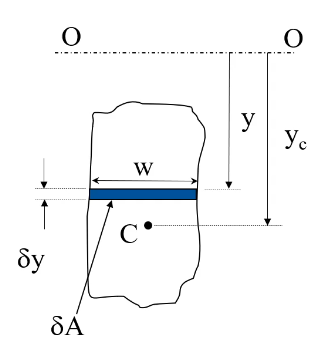
Split the lamina into elements parallel to the chosen axis
Each element has area
The moment of area () of the element is
The sum of moments of all the elements is equal to the moment obtained by assuming all the area is located at the centroid or:
or:
- is known as the first moment of area
Example 1
Determine the location of the centroid of a rectangular lamina.
Determining Location in direction

Take moments for area about
Integrate to find all strips
( can be taken out the integral as it is constant in this example)
but also
so
Determining Location in direction

Take moments for area about :
Integrate
but also
so
Horizontal Submerged Surfaces

Assumptions for horizontal lamina:
- Constant pressure acts over entire surface of lamina
- Centre of pressure will coincide with centre of area
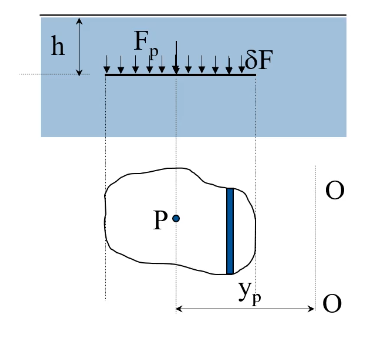
Vertical Submerged Surfaces

- A vertical submerged plate does experience uniform pressure
- Centroid of pressure and area are not coincident
- Centroid of pressure is always below centroid of area for a vertical plate
- No shear forces, so all hydrostatic forces are perpendicular to lamina

Force acting on small element:
Therefore total force is
Finding Line of Action of the Force
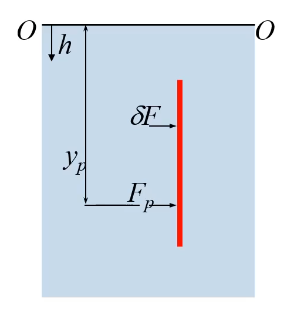
Buoyancy
Archimedes Principle
The resultant upwards force (buoyancy force) on a body wholly or partially immersed in a fluid is equal to the weight of the displaced fluid.
When an object is in equilibrium the forces acting on it balance. For a floating object, the upwards force equals the weight:
Where is the density of the fluid, and is the volume of displaced fluid.
Immersed Bodies
As pressure increases with depth, the fluid exerts a resultant upward force on a body. There is no horizontal component of the buoyancy force because the vertical projection of the body is the same in both directions.
Rise, Sink, or Float?
- equilibrium (floating)
- body rises
- body sinks
Centre of Buoyancy
Buoyancy force acts through the centre of gravity of the volume of fluid displaced. This is known as the centre of buoyancy. The centre of buoyancy does not in general correspond to the centre of gravity of the body.
If the fluid density is constant the centre of gravity of the displaced fluid is at the centroid of the immersed volume.

page generated by gronk